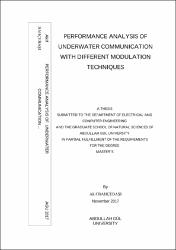| dc.contributor.author | BAHÇEBAŞI, Akif | |
| dc.date.accessioned | 2021-12-28T07:42:12Z | |
| dc.date.available | 2021-12-28T07:42:12Z | |
| dc.date.issued | 2017 | en_US |
| dc.date.submitted | 2017-11 | |
| dc.identifier.uri | https://hdl.handle.net/20.500.12573/1107 | |
| dc.description.abstract | There is an increasing interest in using Underwater Acoustic Sensor Networks (UASNs) for various oceanographic applications, such as pollution monitoring, seismic monitoring, environmental data collection, offshore exploration, and tactical surveillance. As well as underwater sensor nodes, unmanned underwater vehicles are used in some application scenarios of UASNs such as exploration of underwater resources and data gathering in collaboration-requiring missions. UASNs rely on acoustic communications; however, the underwater acoustic channel is highly variable and its link quality depends on environmental factors and the locations of the communicating nodes. Therefore, ensuring reliable communication in UASNs is quite difficult. Moreover, path losses and retransmissions lead to the wastage of energy resources and reduce the network lifetime. In this study, we used well-known underwater modulation schemes to analyse and simulate various underwater scenarios with different depth, distance and BER values in order to make a fair comparison between the modulation schemes and find the optimal transmission power. As proven in our simulation study 32-PSK and 16-QAM techniques achieved the minimum energy consumption rates. Therefore network designers can prolong the underwater network lifetime using 32-PSK and 16-QAM modulation techniques. | en_US |
| dc.language.iso | eng | en_US |
| dc.publisher | Abdullah Gül Üniversitesi, Fen Bilimleri Enstitüsü | en_US |
| dc.rights | info:eu-repo/semantics/openAccess | en_US |
| dc.subject | Underwater Sensor Networks | en_US |
| dc.subject | Modulation Techniques | en_US |
| dc.subject | Performance Analysis | en_US |
| dc.title | PERFORMANCE ANALYSIS OF UNDERWATER COMMUNICATION WITH DIFFERENT MODULATION TECHNIQUES | en_US |
| dc.type | masterThesis | en_US |
| dc.contributor.department | AGÜ, Fen Bilimleri Enstitüsü, Elektrik ve Bilgisayar Mühendisliği Ana Bilim Dalı | en_US |
| dc.relation.publicationcategory | Tez | en_US |


















